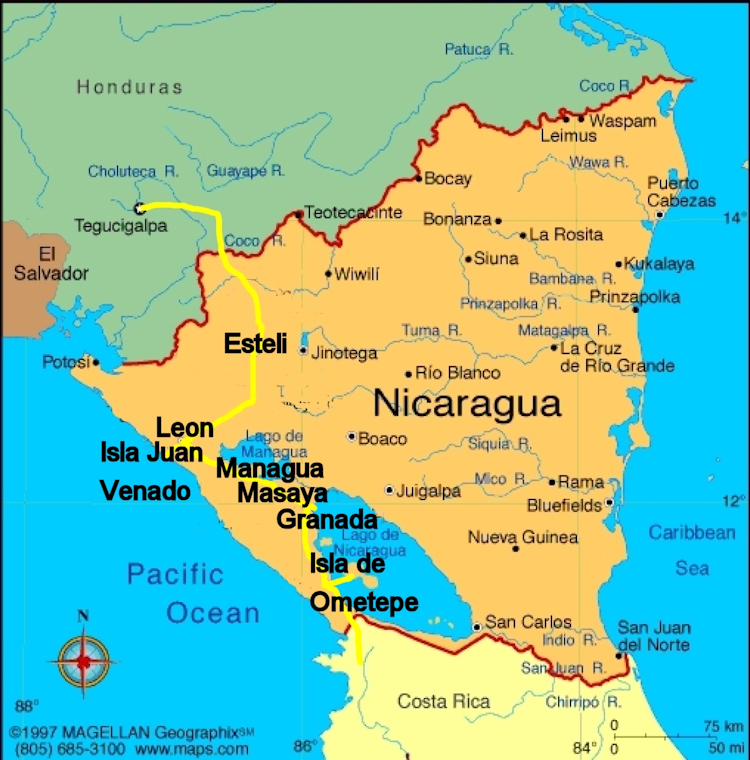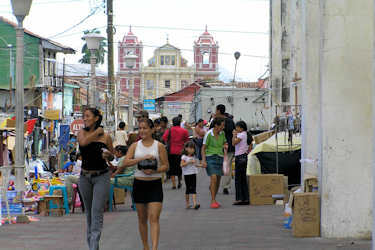Nicaragua

Historie
In pre-Columbian times, in what is now known as Nicaragua, the indigenous people were part of the Intermediate Area,
between the Mesoamerican and Andean cultural regions, and within the influence of the Isthmo-Colombian
area. The Pipil migrated to Nicaragua from central Mexico after 500 BC.
At the end of the 15th century, western Nicaragua was inhabited by several indigenous peoples related by culture to the
Mesoamerican civilizations of the Aztec and Maya. Meanwhile, the Caribbean coast of Nicaragua was inhabited by
other peoples, mostly Chibcha language groups. They had coalesced in Central America and migrated also to present-day
northern Colombia and nearby areas. They lived a life based primarily on hunting and gathering.
In 1502, Christopher Columbus became the first European known to have reached what is now Nicaragua as he sailed southeast
toward the Isthmus of Panama. On his fourth voyage, Columbus explored the Miskito Coast on the Atlantic side of
Nicaragua.
Conquistador Francisco Hernández de Córdoba founded two of Nicaragua's principal towns in 1524: Granada on Lake
Nicaragua was the first settlement, followed by León at a location west of Lake Managua. Córdoba soon built defenses
for the cities and fought against incursions by other conquistadors.
The Captaincy General of Guatemala was dissolved in September 1821 with the Act of Independence of Central America,
and Nicaragua soon became part of the First Mexican Empire.
After the monarchy of the First Mexican Empire was overthrown in 1823, Nicaragua joined the newly formed United Provinces of
Central America. Nicaragua finally became an independent republic in 1838.
Rivalry between the Liberal elite of León and the Conservative elite of Granada characterized the early years of
independence and often degenerated into civil war, particularly during the 1840s and 1850s.
Invited by the Liberals in 1855 to join their struggle against the Conservatives, a United States adventurer named William
Walker set himself up as President of Nicaragua in 1856. Costa Rica, Honduras, and other Central American countries united to
drive Walker out of Nicaragua in 1857, after which a period of three decades of Conservative rule ensued.
In August 1912, the President of Nicaragua, Adolfo Díaz, requested the secretary of war, General Luis Mena, resign for fear
he was leading an insurrection. When the U.S. legation asked President Díaz to ensure the safety of American citizens and property
during the insurrection, he replied he could not, and asked the United States to intervene in the conflict. United States Marines
occupied Nicaragua from 1912 to 1933.
From 1927 until 1933, Gen. Augusto César Sandino led a sustained guerrilla war first against the Conservative regime and
subsequently against the U.S. Marines, whom he fought for over five years. When the Americans left in 1933, they set up the
Guardia Nacional, a combined military and police force trained and equipped by the Americans and designed to be loyal to
U.S. interests.
After the U.S. Marines withdrew from Nicaragua in January 1933, Sandino and the newly elected Sacasa government reached an
agreement by which he would cease his guerrilla activities in return for amnesty, a grant of land for an agricultural colony, and
retention of an armed band of 100 men for a year. Sandino continued to call for the disbanding of the National Guard and, in February
1934, he was assassinated under orders from Anastasio Somoza García, who was director of the Guardia Nacional.
Nicaragua has experienced several military dictatorships, the longest being the hereditary dictatorship of the Somoza family,
who ruled for 43 years during the 20th century ((1927–1979). The Somoza family came to power as part of a U.S.-engineered pact in
1927 that stipulated the formation of the Guardia Nacional to replace the marines who had long reigned in the country. Somoza slowly
eliminated officers in the national guard who might have stood in his way, and then deposed Sacasa and became president on January 1,
1937.
In 1961, Carlos Fonseca turned back to the historical figure of Sandino, and founded the Sandinista National Liberation
Front (FSLN) The Sandinistas took power in July 1979 and José Daniel Ortega became a member of the five-person Junta
of National Reconstruction, which ruled Nicaragua from July 1979 to January 1985.
In the 1990 presidential election, Ortega lost to Violeta Barrios de Chamorro, his former colleague in the junta. Chamorro was
supported by the US and a 14-party anti-Sandinista alliance known as the National Opposition Union, an alliance that ranged from
conservatives and liberals to communists.
In 2006, Daniel Ortega was re-elected as president of Nicarague gaining with 38% of the vote's.
I have visited Nicaragua in december 2004
It was part of my 30 days trip to Central America.
These are the places i have seen
Esteli
Leon
Isla Juan Venado
Managua
Granada
Mombacho
Isla de Ometepe
Please let me know when you're having questions.
i would be pleased to help you.
Things to do and other tips
